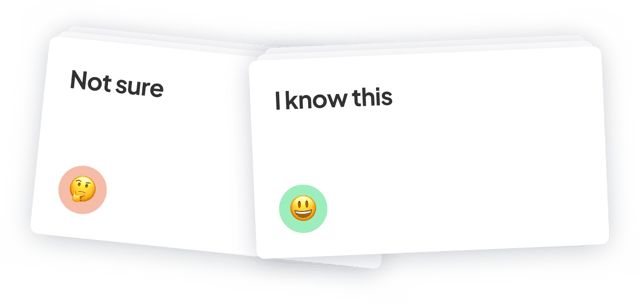4.6 Employment & Unemployment (Cambridge (CIE) IGCSE Economics) Flashcards
Exam code: 0455 & 0987
1/30
0Still learning
Know0
Define employment.
Employment is the economic use of labour as a factor of production.

Sign up to unlock flashcards
Join for free to unlock a full flashcard set, track what you know,
and turn revision into real progress.Define unemployment.
Unemployment means someone is not working, but actively seeking work.
Define labour force.
The labour force consists of all people who are actively working plus those unemployed but seeking work.
Did this page help you?
Cards in this collection (30)
Define employment.
Employment is the economic use of labour as a factor of production.
Define unemployment.
Unemployment means someone is not working, but actively seeking work.
Define labour force.
The labour force consists of all people who are actively working plus those unemployed but seeking work.
What is full employment in an economy?
Full employment describes the situation where everyone willing and able to work has a job.
The unemployment rate is calculated as the number of those seeking work divided by the total force, times 100.
The unemployment rate is calculated as the number of those actively seeking work divided by the total labour force, times 100.
True or False?
A country’s unemployment rate does not include people who have given up looking for work.
True.
The unemployment rate only includes people who are actively seeking work, not those who have become economically inactive.
The rate measures the number of people currently working as a percentage of the working-age population.
The employment rate measures the number of people currently working as a percentage of the working-age population.
What does the labour force participation rate show?
The labour force participation rate shows the proportion of the total population that is in the labour force (either employed or actively seeking work).
What is the Labour Force Survey (LFS)?
The Labour Force Survey (LFS) is a regular survey of households to measure unemployment, using the International Labour Organisation definition.
Name one advantage and one disadvantage of using the Labour Force Survey to measure unemployment.
An advantage is that it includes people not registered for benefits, giving a broader measure. A disadvantage is that it is based on a sample, which may not represent the population accurately.
Define long-term unemployment.
Long-term unemployment is when a person remains out of work for an extended period of time, often leading to more serious negative effects on individuals and the economy.
Unemployment can lead to increased and anti-social behaviour in society.
Unemployment can lead to increased crime and anti-social behaviour in society.
What is one direct impact of unemployment on individuals?
One direct impact of unemployment on individuals is the loss of income, which reduces their ability to purchase goods and services.
How can unemployment affect firms?
Unemployment can lead to a loss of sales revenue for firms, as unemployed consumers spend less.
When many people are unemployed, the government collects less and must spend more on benefits.
When many people are unemployed, the government collects less tax revenue and must spend more on benefits.
What is structural unemployment?
Structural unemployment occurs when there is a mismatch between the skills of workers and the jobs available. This often happens when industries decline or move location.
Define seasonal unemployment.
Seasonal unemployment is when labour is not required at certain times of the year, such as fruit picking or tourism jobs.
Cyclical unemployment is caused by a fall in demand in the economy.
Cyclical unemployment is caused by a fall in total demand in the economy.
True or False?
Frictional unemployment is usually long-term and involuntary.
False.
Frictional unemployment is usually short-term and voluntary, as workers are between jobs by choice.
Define cyclical unemployment.
Cyclical unemployment is unemployment caused by a fall in total demand in the economy, often during a recession.
Define expansionary fiscal policy.
An expansionary fiscal policy is a government policy that aims to increase total (aggregate) demand by increasing government spending or reducing taxes.
How does decreasing personal income tax reduce unemployment?
Decreasing personal income tax increases households' discretionary income, leading to higher consumption. To meet the increased demand for goods and services, firms hire more workers, which reduces unemployment.
The demand for labour is from the demand for goods and services.
The demand for labour is derived from the demand for goods and services.
Define supply-side policies.
Supply-side policies aim to improve the quantity and/or quality of the factors of production, raising potential output in the economy.
True or False?
Reducing trade union power is an example of a supply-side policy to reduce unemployment.
True.
Reducing trade union power can lower production costs and encourage firms to hire more workers, which is a supply-side approach to reducing unemployment.
The government introducing long-term training subsidies for students of green technology can increase the of skilled workers in the industry, helping to reduce unemployment.
The government introducing long-term training subsidies for students of green technology can increase the supply of skilled workers in the industry, helping to reduce unemployment.
Which type of government policy is most effective for reducing cyclical unemployment?
Demand-side policies are most effective at reducing cyclical unemployment because they increase total demand in the economy.
Frictional, seasonal, and structural unemployment are best addressed by -side policies.
Frictional, seasonal, and structural unemployment are best addressed by supply-side policies.
True or False?
Expansionary monetary policy is equally effective for all types of unemployment.
False.
Expansionary monetary policy is most effective for demand-side (cyclical) unemployment, but not for frictional or structural unemployment.
Why might supply-side policies take longer to reduce unemployment than demand-side policies?
Supply-side policies often involve long-term changes such as training or regulatory reform, which take time to impact the economy, while demand-side policies can increase employment more quickly by immediately raising total demand.
Sign up to unlock flashcards
or
By signing up you agree to our Terms and Privacy Policy